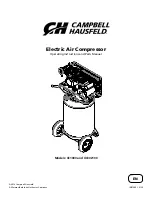
13-21-615 v01 Page 15
Figure 2-3 COLD WEATHER INSTALLATION
INSTALLATION FOR COLD WEATHER OPERATION
(Figure 2-3) It is recommended that the unit be
installed inside a shelter that will be heated to temperatures above freezing (32
F, 0
C). This will eliminate
many of the problems associated with operating units in cold climates where freezing rain, drifting snow,
freezing condensate and bitter cold temperatures are encountered.
Refer to Engineering Data Sheet 13-9-411 for the advantages of using the heat recovered from rotary
compressors. This heat recovery could easily pay for an adequate shelter for the unit.
When an outside installation must be made, the precautions required will depend on the severity of the
environment. The following are general guidelines for outside installations:
Cold Weather
(Down To +10
F, -12
C)
1.
Be sure all drains, traps, and control lines, including pressure transducer lines are heated to avoid
freezing of condensate. Heat tape with thermostat control is generally satisfactory for this purpose
and can be obtained at various local plumbing or hardware outlets at nominal cost.
2.
If an air-cooled aftercooler is to be used, provisions to bypass the aftercooler must be made. Since
cold air contains very little moisture, successful operation can be achieved without the aftercooler.
3.
Provide at least some simple shelter such as a plywood windbreak to protect against drifting snow.
4.
Use only Gardner Denver AEON 9000 SP lubricant.
5.
Monitor the unit carefully during start-up and operation to be sure it is functioning normally.
















































